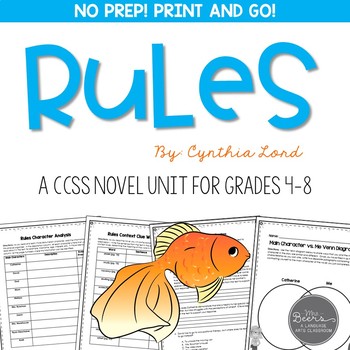Rules Novel Study Unit - Common Core Aligned
- PDF
- Internet Activities
- Easel Activity
What educators are saying
Description
A no prep, print-and-go novel unit for Rules by Cynthia Lord. Includes chapter-by-chapter reader response questions, engaging journal prompts, character analysis work, lesson plans, answer key, and more!
If you are looking for the perfect summertime novel to inspire your upper elementary to middle school readers, Rules by Cynthia Lord is a must read.
This 61-page print and go novel unit includes:
• lesson plans for seamless implementation
• 22-pages of chapter by chapter reader response questions
• character analysis work
• 9-pages of context clue word work
• story map
• end of novel compare and contrast writing project
• figurative language work
• post-reading journal prompts
• CCSS covered
• answer key
Summary of the novel:
Catherine is looking forward to summer and meeting her new same age neighbor. As her family navigates life with her autistic brother, David, through weekly appointments and monitoring him at all times, little time is left for Catherine. While she misses her best friend who is visiting her dad for the summer in California, she makes an unlikely friend that proves that true friendship comes when you aren't looking for it.
Your students will zip through this high-interest novel while working to consider the importance of how we treat one another because we never know a person's entire story until we ask and listen.
Stock up and save on ELA novel units with this bundle...
*********************************************************************
I would LOVE your feedback on this resource. Leaving feedback earns you points that will discount future Tpt purchases. Also, be sure to FOLLOW me so you are aware of all of my new resources as soon as they are posted!
Happy Reading!
Erin
*********************************************************************
********************************************************************
ELA Standards:
RL.4.1, RL.4.3, RL.4.4, RL.4.5, RL.4.6
RL.5.1, RL.5.2, RL.5.3, RL.5.4, RL.5.5, RL.5.6
RL.6.1, RL.6.2, RL.6.3, RL.6.4, RL.6.5, RL.6.6
RL.7.1, RL.7.2, RL.7.3, RL.7.4, RL.7.5, RL.7.6
W.4.4, W.5.4, W.6.4, W.7.4, W.8.4






